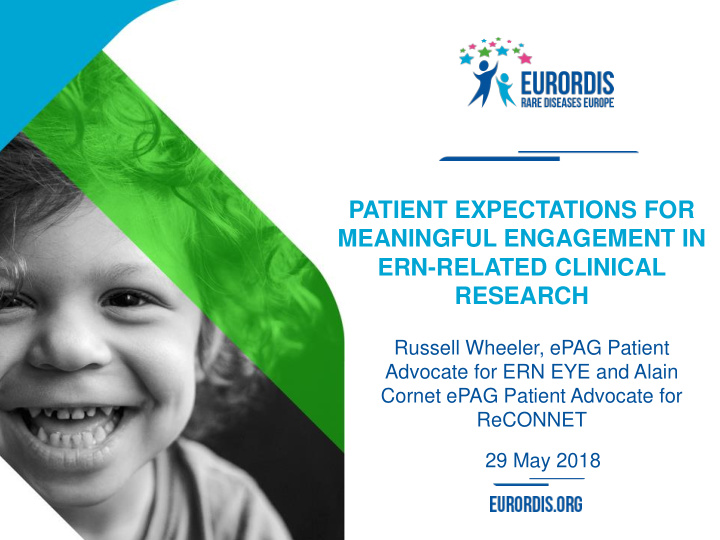



PATIENT EXPECTATIONS FOR MEANINGFUL ENGAGEMENT IN ERN-RELATED CLINICAL RESEARCH Russell Wheeler, ePAG Patient Advocate for ERN EYE and Alain Cornet ePAG Patient Advocate for ReCONNET 29 May 2018
1. PATIENT EXPECTATIONS FOR MEANINGFUL ENGAGEMENT IN ERN – RELATED CLINICAL RESEARCH (1/2) 1. Patients need to be partners across the clinical trial pathway and their engagement needs to be considered early on in the process. Patients should co-build clinical trials from their design to the communication of results – be involved end to end. It is important to share with us the results and also ommunicate partial results throughout the clinical trial. 2. Involve patients in identifying what outcomes will be measured and how they will be assessed (not only health-related outcomes, but also wider quality of life-related outcomes).
1. PATIENT EXPECTATIONS FOR MEANINGFUL ENGAGEMENT IN ERN – RELATED CLINICAL RESEARCH (2/2) 4. Education for patients in the basic concepts of research, clinical trial's processes and terminology is needed to encourage patients to participate in research activities. But patients need to remain patients - not epidemiologists or physicians - and contribute from their own experience of living with the disease. 5. Education for researchers, regulators and HTAs on how to partner with patients on research-related activities – all stakeholders need to understand how to embed patients’ voice and value their contribution
2. PATIENTS PERSPECTIVES ON ERNs ADDED VALUE FOR RESEARCH (1/2) We need to have a harmonised approach to ERNs, there needs to be common denominators to define what ERNs are and what they will do in terms of clinical research. This does not mean that they should all start with “the same things” but rather focus on the lowest hanging fruits and the most effective progress for each ERN based on its “current state of play” , i.e. leave fair flexibility in each ERN within a clearly defined overall objective.
2. PATIENTS PERSPECTIVES ON ERNs ADDED VALUE FOR RESEARCH (2/2) 1. ERNs provide access to a large number of patients. This can simplify and streamline the recruitment of patients for clinical trials but also facilitate consultation with patients and gathering their feedback Bring the clinical trial to the patients rather than bringing the patients to the clinical trials: ERNs are in a good position to ease the preparation to set up international clinical trials, simplify the recognition of trial sites, ease recruitment of patients. If the ERN is recognised as a single site, each of its member should be able to bring in their patients without the need for assessing each site separately. ERNs can pool together the expertise needed to help in better validating and assessing patients’ diagnosis in the recruitment phase 2. ERNs are very well positioned to build platforms and infrastructure for collaborative research with a standardized approach and broader focus - beyond a single disease area - Perfect curators to collect real world data and real life labs to conduct natural history studies. They should leverage on the existing research tools and infrastructure available and further enhance and enrich them / avoid duplicating efforts .
Thank you
Recommend
More recommend